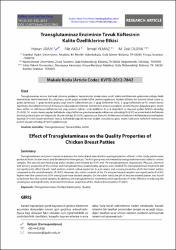Transglutaminaz Enziminin Tavuk Köftesinin Kalite Özelliklerine Etkisi
Citation
Uran, H., Aksu, F., Yılmaz, İ., Durak, M. Z. (2013). Transglutaminaz Enziminin Tavuk Köftesinin Kalite Özelliklerine Etkisi. Kafkas Üniversitesi Veterinerlik Fakültesi Dergisi. 19 (2): 331-335Abstract
Transglutaminaz enzimi katılarak işlenmiş gıdaların, başta tekstür olmak üzere çeşitli kalite özelliklerinde gelişmeler olduğu farklı kaynaklarda belirtilmektedir. Bu çalışmada, tavuk göğüs etinden köfte üretimi yapılmıştır. Yapılan köfteler biri kontrol olmak üzere üç gruba ayrılmıştır. 1. grup kontrol grubu olup, enzim kullanılmamıştır. 2. grup köftelerde %0.5, 3. grup köftelerde ise %1 enzim ilavesi yapılmıştır. Bu köftelerin fiziksel, kimyasal ve duyusal özelliklerinin belirlenmesi amacıyla analizler yürütülmüştür. Bulgulara göre, enzim ilave edilen ve edilmeyen köftelerde kül, yağ, protein miktarı, renk özellikleri (L, a, b değerleri) ve duyusal açıdan farklılık olmadığı (P>0.05); %1 enzim ilavesi yapılan köftelerde, diğer köftelere göre kurumadde miktarının yükseldiği (P<0.05) ve enzim katkılı köftelerde kontrol grubuna göre pH değerinde düşme olduğu (P<0.05) saptanmıştır. Bununla birlikte enzim katkısının köftelerde pişirme kaybını azalttığı (P<0.05) tespit edilmiştir. Ayrıca, köftelerde yapılan tekstür analizi sonuçlarına göre, enzim katkısının köftelerin tekstürünü önemli ölçüde arttırdığı (P<0.01) gözlenmiştir. Transglutaminase enzyme is known to improve the textural and several other quality properties of food. In this study, patties were produced from chicken breast and dividend into three groups. The first group was not treated by transglutaminase and called as control samples. The second and third group patty samples were treated by 0.5% and 1% transglutaminase, respestively. Physical, chemical and sensory properties of the control and transglutaminase treated patty samples were studied. The transglutaminase treatment did not significantly affect the ash, lipid, protein content, colour properties (L, a, b values) and sensory properties of chicken breast patties compared to the control samples (P>0.05). However, dry matter content of the 1% enzyme treated samples was significantly (P<0.05) higher than the control and 0.5% transglutaminase treated samples. On the other hand, the pH of enzyme treated patties was found to be lower than the control samples. In addition, the transglutaminase treatments were significantly (P<0.05) effective in reducing the cooking loss and significantly improved the textural properties of the chicken breast patties (P<0.01).
Source
Kafkas Üniversitesi Veterinerlik Fakültesi DergisiCollections
- Makale Koleksiyonu [282]



















